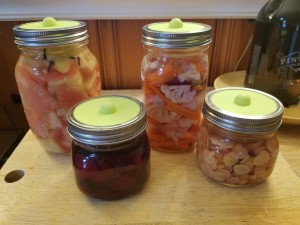Ginger Take 2 and Watermelon Rinds
July 6, 2019
The last attempt at Pickled Ginger went bad so I’m giving it another go. I believe I had two problems last time:
- Low salinity
- Too much brine
The recipes I found were by volume which should always be regarded with suspicion. A tablespoon of shaker salt has more actual NaCl in it than the same volume of course salt. To convert recipes I used this online converter and assume fine grained salt to calculate weight of 1 teaspoon at 5.69 grams, 1 tablespoon at 17.06 grams.
My lesson learned regarding brine amount is completely pack the jar with vegetable. The job of lactobacilli is to acidify your brine by converting sugars to lactic acid. Without packing the jar, there are fewer critters to do the work and they don’t have enough sugar to work with. Without enough food, the good bacteria simply can’t produce enough acid to suppress microorganisms that cause spoilage.
So, armed with fresh insights it’s time for new batches!

Ginger
Because the last batch spoiled I changed some things. 3% salt this time and a half-quart jar so I could pack it full of vegetable. I also added a slice of beet to tint it all pink… only very young ginger has that pink color you might know from sushi restaurants.
Watermelon Rind
I used this recipe I found with a quick search: Lacto Fermented Watermelon Rind Pickles. It’s a salt-by-volume one so I did a conversion. It calls for 1 tablespoon of salt in a quart jar. 1 quart is 946ml, 1 ml is 1 gram, 1 tablespoon is 17 grams so… 17/946 = 0.0179. The recipe is 1.8% salinity brine.
For my batch the vegetable plus water weighed in at 919 grams. I’m doing 2% for more crispiness and to ward against spoilage.
919 / 100 * 2 = 8.4 grams salt
We’re out of mustard seeds so I made stuff up.
- 1/8 tsp pepper flakes
- 1/2 tsp sliced ginger (snatched from the other jar)
- 1 clove garlic, smashed
Gardiniera and Beets
Nell wanted pickled cauliflower so I mixed them with some carrots. 2% salinity. I didn’t add any herbs or garlic b/c it’s been a long time since I did these and want to try their natural flavor. I did add a slice of beet. Later I might add a bit of stevia.
Beets are one of the easiest ferments around. I used a half-quart b/c we don’t eat them very quickly. Really good on salads.
2% salt.
Tip: Weighing and Measuring
The best way I’ve found is to first weigh the empty jar, making a note of the weight in grams.
Now stuff it. Use a tamper if you have one. For things like cucumbers, okra, and tomatoes, take care not to break them open. Fill the jar up to an inch from the top with filtered water.
Weigh the filled jar and subtract the weight of the empty jar. This is the weight of your batch. Divide by 100 then multiply by the % salinity you need.
Hold fingers over the top of the jar and pour the water into a bowl for mixing salt and spices.
Filed under: Uncategorized | Comments (1)
Reporting back on results of these batches.
Ginger
BLECH! Woody, funky, not at all like the pallet cleansing ginger served with sushi. I’m giving up on this… seems to be best suited for a vinegar pickle.
Beets
Fabulous. These are really hard to get wrong. I added 5 drops of stevia in the 1/2 quart jar to try and sweeten them up. Didn’t really register so I’ll add more next time.
Gardiniera
Great! Good crunch, the pink color added by a beet slice was lovely looking. It was a plain salt brine, I think garlic and dill would punch it up. I added 3 drops of stevia and that had a nice balancing effect.
Watermelon Rind
These are a hit with everyone that’s tried them… except Lynell! 🙂 The clove adds a subtle flavor and the bit of head from pepper flakes is also nice. 5 drops of stevia in a quart added a nice sweet note. Honestly though I made them too salty. They soak up tons of brine and for Lynell that’s all she tasted… salt. Next time I do it I’ll reduce this to 1.5%.